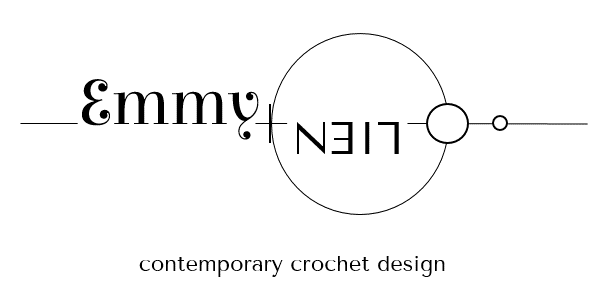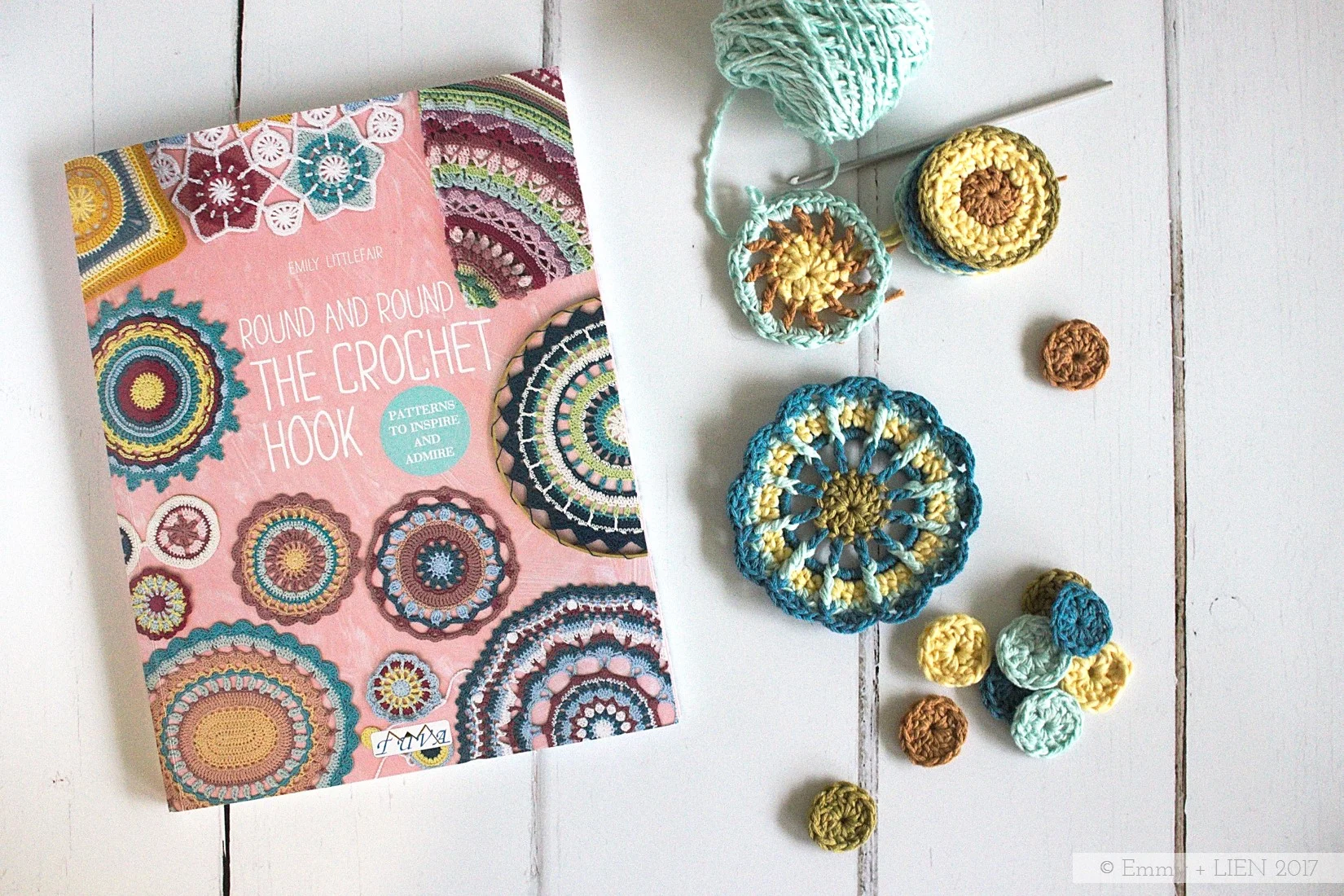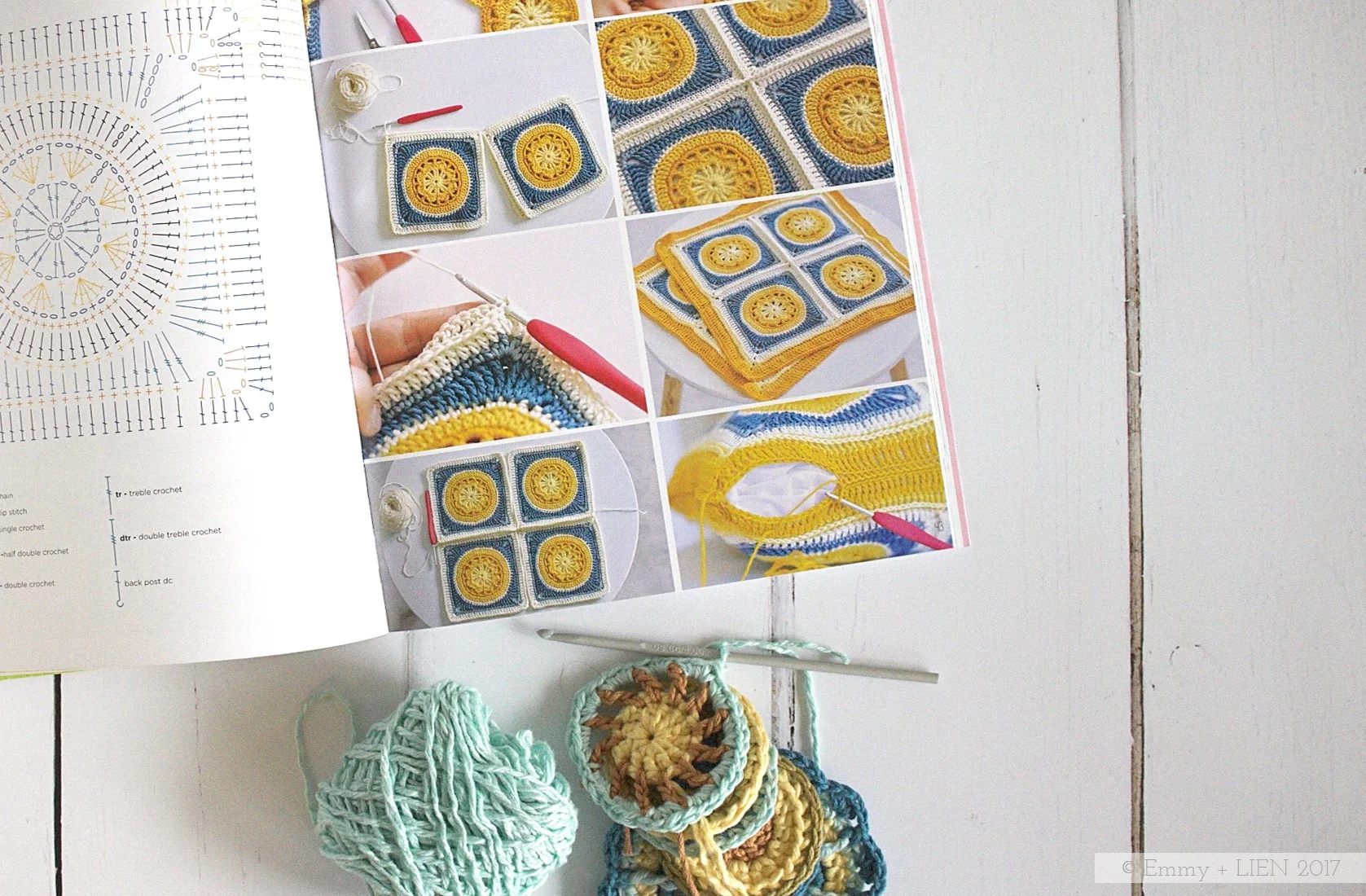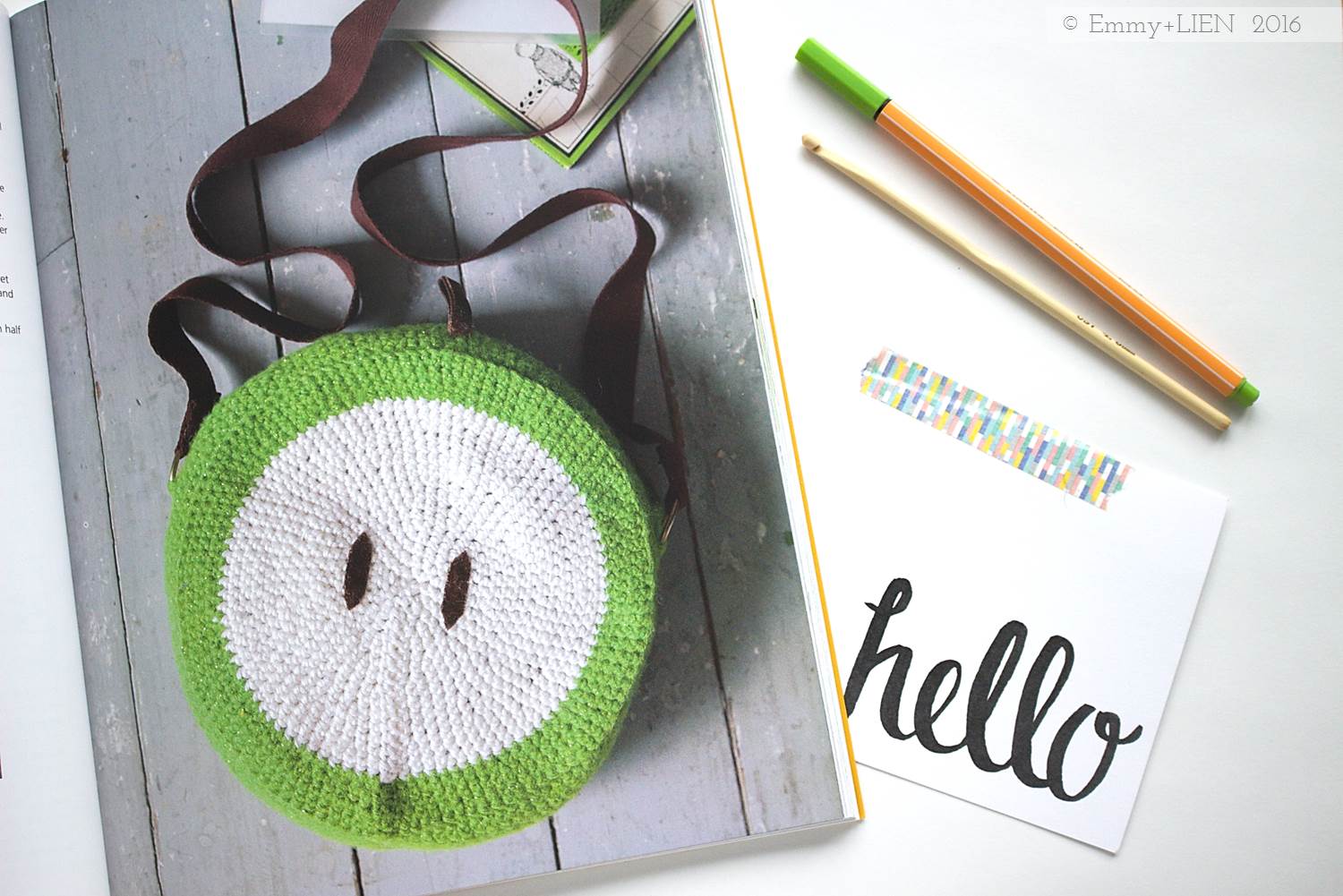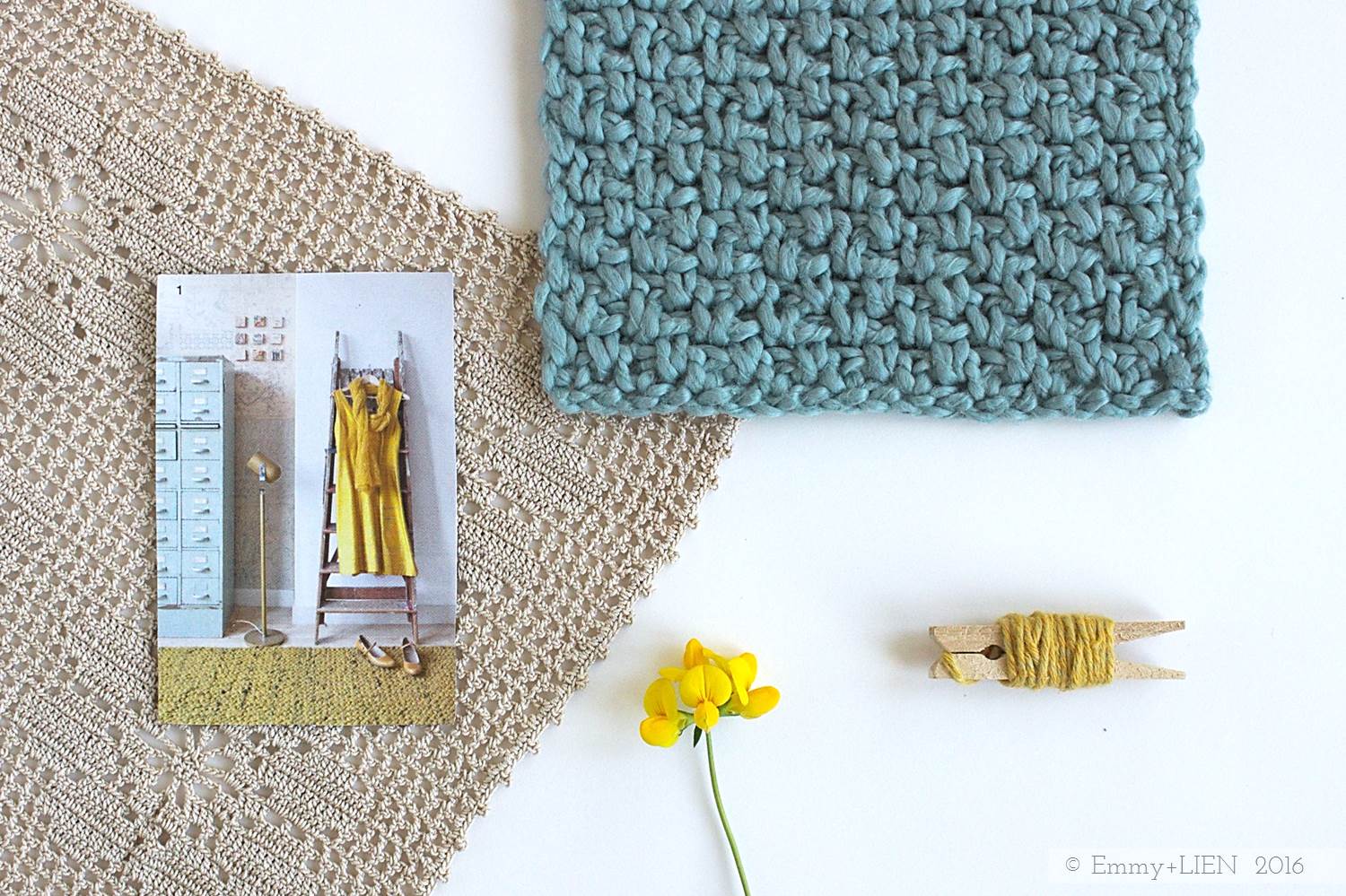BOOK REVIEW: Round and Round the Crochet Hook
A review of Round and Round the Crochet Hook, a beautiful new book by Emily Littlefair (aka The Loopy Stitch).
My crojo has gone missing. Do you know what crojo is? It stands for "crochet mojo" and, as with so many things, I didn't know it was "a thing" until I saw someone mention it on instagram. It's that feeling when you're so into a project you dont want to put it down at all, when you're full of inspiration for what to make, when you're generally just so crochet-y. Usually, that's me. Since baby 2, not so much.
It's okay, I know exactly why it's happened to me at this time. Crochet is my Creative Thing, but it's hard to be innovative and original when you're so sleep-deprived you can barely string a sentence together. It all goes in phases, doesn't it, and in the meantime I'm thankful I have knitting as my Making Thing.
I do miss it though. The weight of the hook in my hand, zipping through rows (god, knitting is slow), my favourite familiar textures...
So when Emily Littlefair (who you may know as The Loopy Stitch) asked whether I'd like to take part in a virtual tour for her new book, I jumped at the chance. Emily's IG page is full of gorgeous crochet, and I thought, what better way to try to tease my crojo back but with one of her patterns?
The new book is called "Round and Round the Crochet Hook", and contains 19 patterns that are all worked in the round. Most of them are small, reasonably quick projects, but there is one stunner of a blanket as well. Each pattern comes with detailed written instructions, complete stitch charts, and clear project photos. At the back of the book there's a handy "Crochet Basics and Techniques" section as well.
When I received the book, the first thing that struck me was how pretty it is. As you'd expect from Emily, the colour palettes are very, very beautiful, with just the right balance between bright and sophisticated. We're in the depths of gallingly-grey November days here, and even just flipping through the pages is a enough for a bit of a visual pick-me-up.
The other thing I really like is how clever the whole thing is. I've always admired crochet mandalas, both for how they look and for their meditative round-and-round-and-round construction - but I don't often make them because, well, what do you do with them all? Emily has anwsered that question for me: you make cushions, coasters, table runners, wall hangings... And you end up with truly beautiful as well as usable pieces for the home.
It was such fun flicking through this pretty book in a quiet, baby-is-finally-napping moment. I made tea, my favourite crochet notebook came out...
In the end, I chose the Spotty and Dotty garland as my first project. I'm using bits of leftover Vinnis Colours cotton and bamboo because I just love the colours. We're doing up the boys' room at the moment, so that's where it will go, assuming I can bear to part with it! I'm pleased to say I'm really enjoying making it, to the point where I'm already toying with the idea of making them a rug from the book in matching colours.
Well hello there crojo, my old friend...
Round and Round the Crochet Hook by Emily Littlefair is published by Tuva Publishing and available to buy now. Thank you to Emily and Tuva Publishing for giving me the opportunity to review this lovely book and take part in the virtual book tour (for a full list of participants, click here).
YARN REVIEW: Blacker Yarns Lyonesse
Lyonesse by Blacker Yarns is a 50/50 blend of linen and wool. Find out what it's like to work with and what to use it for.
What kind of yarn is it?
- Lyonesse by Blacker Yarns is a 50/50 blend of linen and wool (Falkland Island Corriedale or Merino). It's available in both 4-ply and DK weights. The swatches shown use the DK, with a 4mm hook for the crochet swatch and 3.5mm needles for the knitted one.
- The combination of linen and wool gives Lyonesse a very interesting feel; it's a little stiff at first but soon softens up. Once blocked it really relaxes into a wonderful suppleness.
- Lyonesse comes in a range of 15 shades, including one undyed neutral.
Who makes it?
Lyonesse is made by British company Blacker Yarns, who are part of specialist wool millers The Natural Fibre Company. The company's main focus is on high-quality, natural, UK-sourced and produced yarns. It pays fair prices for all the fleeces it buys, so as to help support British farmers. Animal welfare and appropriate waste disposal are also of high priority.
Plus Points?
- Each of the fibres used in Lyonesse brings its own characteristic to the finished material. The linen adds crispness and strength, while the wool lends softness and memory. In other words, what you get is excellent stitch definition with just a touch of fluffiness. It also has the typical "give" you would expect from linen, but doesn't go overly baggy thanks to the wool. It retains its blocked shape amazingly well.
- The shade range isn't huge, but it is versatile in that each colour has a good depth to it and is very wearable.
- Merino or similar wools can be quite fragile on their own, but the addition of linen makes this much more hardwearing. It is clearly meant to be used for items that will really be worn and loved for a long time.
Negatives?
- Stiff, dense fibres such as linen and cotton can be quite tough on the joints. Although this yarn is soft to the touch, I did feel fatigue in my fingers and wrist especially when crocheting with it for a long time.
- Availability of all the shades isn't constant, but depends on when each season's fleeces come in. Blacker are very helpful when you get in touch to ask about their stock though!
What should I use it for?
Lyonesse is a good mid-season to summer yarn and would make beautiful lacy or cabled garments as well as accessories.
Suggested pattern: Betty Bolero
Note: I was not compensated in any way for writing this review
YARN REVIEW: de rerum natura Ulysse
Ulysse by de rerum natura is a merino yarn produced in France in an ecologically and ethically sound way. Find out what it's like to work with and what to use it for.
What kind of yarn is it?
- Ulysse by de rerum natura is a carded, 100% merino yarn blended from two to three different sheep breeds.
- It's a 2-ply sport weight yarn with a recommended needle size of 3 to 3.5mm. As a loose crocheter, a 3mm hook works best for me. For knitting, 3.5mm wooden needles gave me 24 sts by 36 rows.
- As this is a non-superwash merino, it has a great structure with plenty of bounce and crunch. It does not feel like a slinky, shiny superwash merino at all. Rather, it feels soft in a natural, sheepy way.
- Ulysse comes in a range of 25 shades, including earthy neutrals, soft pastels and a few brights. All shades are available in 50g balls, and the neutrals are also available in 100g hanks.
Who makes it?
Ulysse is made by French company de rerum natura, who aim to create yarns that respect both the animals and people responsible for producing them. The sheep are reared humanely in France or Portugal, and all yarn processing is carried out as ecologically as possible in France.
Plus Points?
- Where appropriate, Ulysse is blended from the fleeces of both white and black merino sheep before being dyed. The result is an incredible depth of colour that manages to look rich as well as earthy.
- Thanks to its slightly crunchy, firm structure this yarn holds stitches very well and is an absolute joy to work with.
- Being merino, it's still soft and fluffy enough to consider wearing next to the skin. It softens further with time.
- It feels lightweight yet warm when worn.
Negatives?
- This yarn is reasonably easy to "break" - pull hard enough on a strand and it will come apart. Thankfully it isn't actually splitty, but when joining two strands with a knot, for example, care needs to be taken. I do also wonder how areas such as elbows would stand up to heavy wear.
- Ulysse should only be handwashed, so you may not want to use it for items that need washing frequently (i.e. baby knits!).
What should I use it for?
Ulysse is especially suited to colourwork such as fairisle, fine cables or lace. It works just as well for garments as for accessories - think feminine cardies, big beautiful shawls or fairisle beanies.
Suggested pattern: Hanabira cardigan
Note: I was not compensated in any way for writing this review
BOOK REVIEW: 35 Crocheted Bags by Emma Friedlander-Collins
My instabuddy and crochet cohort Emma Friedlander-Collins has just published a new book, 35 Crocheted Bags. Read on to find out more about it!
There is something so hands-up-in-the-air, so YAY about your instabuddies and crochet cohorts achieving great things, like getting a local shop to sell their wares or publishing an entire book. Emma Friedlander-Collins, who you might also know from Steel & Stitch or Crochet Girl Gang fame, has just gone and done the latter (for the third time, no less!): 35 Crocheted Bags is out. I love Emma's work so when the opportunity came up to review a copy, I jumped at it.
35 Crocheted Bags is divided into 3 chapters:
chapter 1 - totes and holdalls
chapter 2 - bags and handbags
chapter 3 - in your bag (small items like purses, phone sleeves and so on)
Each design includes all the essentials you would expect: beautiful, clear photographs, pattern information, detailed written instructions, graphs where required. In addition, Emma has included a sweet little introduction to each item, explaining what inspired it and how she might use it herself.
The book covers an impressive range of styles and colour palettes. Emma's signature look - bright colours and fun, retro designs (I think the girl has a thing for skulls!) - is unmistakably there, but you'll also find more muted colours and minimalist styles.
The same goes for the range of "bag types". There are frivolous clutches, sensible shoppers, and ultra-practical little purses and wallets. Below are some of my favourite patterns from each chapter.
the spring shopper
the mini satchel
the foxy crochet carry case
...and my absolute favourite, the apple shoulder bag!
The book also includes a "techniques" section. It covers everything from basic crochet stitches, tapestry crochet, and blocking your pieces, to sewing a fabric lining and attaching buttons. As a result, 35 Crocheted Bags really is suitable for any level of crochet (or sewing!) skill; Even a complete beginner should find a few patterns to get stuck into straight away.
All in all, it's a fabulous book full of patterns that look like they'd be great fun to make, but also to wear and use. Now I'm off to make that apple bag!
35 Crocheted Bags by Emma Friedlander-Collins is published by CICO Books, and is available now for £12.99.
Disclosure: I was sent a copy of 35 Crocheted Bags for the purpose of this review, but all words, photos and opinions are my own.
YARN REVIEW: MoYa Whisper
MoYa Whisper is a line of 100% organic cotton in 19 soft, powdery shades. Find out what it's like to work with, what to use it for and where to get it.
What kind of yarn is it?
- MoYa Whisper is a 100% organic cotton. It's a standard Double-Knitting (DK) yarn, with a recommended hook size of 3.5 to 4.0 mm (needle size 3 to 4 mm). For a loose crocheter like me, 3.5 mm is spot on.
- This yarn is hand dyed, so each ball has its own unique colour gradation. The peach shade pictured above ranges from a very light baby pink to a dark raspberry. However, each ball within a dye lot has the same base colour, so they do of look good together.
- The colour range includes 19 powdery shades, with a good number of neutrals and a few delicious brights thrown in.
image credit: scaapi.nl
Who makes it?
MoYa Yarn is based near Cape Town in South Africa. The company is run by a mother and daughter team, who specialise in hand-dyed, unique yarns.
Plus points?
- MoYa Whisper has a high twist, meaning it absolutely does not split. When you're doing fiddly stitches such as puffs, this is a godsend!
- Like all cotton yarns it's fairly dense, but it still feels soft and supple to work with. I've found it softens up more over time, too.
- The colours are to. die. for.
- It's organic!
Negatives?
My only complaint is that MoYa yarns are still a little tricky to get hold of in some parts of the world. However, I know its distributors as working hard to change this. For European stockists you can check Scaapi's website, and the Australia & New Zealand market is covered by intambo.
What should I use it for?
MoYa whisper is perfect for baby and children's items such as blankets, sweaters, hats, etc. Even though cotton is usually recommended for wash cloths and the like, I wouldn't use this yarn for those - it's just too nice!
Suggested pattern: Peach Pocket Tunic
Disclosure: I received one ball of MoYa Whisper as a sample. The decision to write this review, and all opinions and words included in it, are my own.
Sea Water, Sun and Yarn
Now the autumn/winter proposals have been handed in, it's time for a little late Spring sneaky peeking. Add in a mini yarn review, "sea water" and "sun", and it feels like we're heading for a great summer.
Yesterday I handed in a stack of autumn/winter design proposals. Now I just have one or two more things to try out for the Emmy + LIEN label, and then I think I can draw a line under all things dark and wintry. Only until the sample making starts, of course, but the initial head-scratching part is done. The result: a stack of swatches. About a month's worth of work. Doesn't look like much does it?!
One late summer design has snuck in there, and I wanted to pull it out for a little sneaky peek. And a yarny drool.
Meet my new crush: Pickles. They're based in Oslo and, oh my, don't they ever produce deliciousness. I ordered two types (for now!), Summer Wool and Thin Organic Cotton.
Summer Wool consists of 70% organic cotton and 30% fair trade Peruvian merino. Plant-dyed, entirely scrumptious, and swiftly set aside for a knitted cardigan for Yours Truly (more on that another day).
Thin Organic Cotton isn't actually that thin - it works up almost like a worsted weight rather than a DK - but it is very lovely. It feels much softer than 100% cottons usually do, and so it's perfect for a summer to mid-season vest design I've had in mind. Though I normally get lead times spectacularly wrong, this *should* be coming out fairly soon. Swatch done, colours picked, mood board fun had. First test subject: the Bean (though I think it'll be a child to adult pattern - I want me some of this too!).
I'm waiting for the rest of the yarn I need to make up the sample to arrive. I settled on this muted "sea water" blue, and added a yellow called "sun". Sounds like a perfect summer of making to me.
Just so you know: I have not been compensated in any way for writing this post.
YARN REVIEW: Sirdar Snuggly Baby Bamboo
The Baby Bamboo line is one of Sirdar's most popular yarns. Find out what it's like to work with, what to use it for, and whether it really is appropriate for baby knits.
What kind of yarn is it?
- Sirdar Snuggly Baby Bamboo consists of 80% bamboo viscose and 20% wool. It's a Double-Knitting (DK) yarn but sits on the fluffy end of the scale, and so best used on 4mm needles/hook (US size 6 needles or a f/5 hook).
- The colour range includes 35 shades, with 4 new colours having been added recently.
Who makes it?
The manufacturer is Sirdar Spinning Ltd., a British yarn company established in 1880.
Plus points?
- Sirdar Snuggly Baby Bamboo is one of the softest, smoothest yarns I've ever worked with. It has a slight gloss to it and doesn't split easily as you knit or crochet.
- Despite its softness it gives great stitch definition, making it suitable for a wide range of items.
- The colour range is impressive and includes vibrant brights, neutrals, and pastels.
Negatives?
This is a 80% bamboo viscose yarn which, put very briefly, means that it is a synthetic product. Although bamboo fibre is used as the base material, to become yarn it has to undergo a lengthy and chemically-intensive process that results in large amounts of hazardous waste. Unless this process took place at an Oeko-Tex certified facility with proper waste processing systems, the bamboo viscose is not ecologically sound, nor any "safer" for babies than standard non-organic cotton.
[Source: http://www.cbc.ca/news/bamboo-textiles-no-more-natural-than-rayon-1.938759]
I've emailed Sirdar to ask where they source their bamboo from, but unfortunately I haven't yet received a reply. Untill then, despite its name I personally wouldn't use this yarn for baby and children's knits.
What should I use it for?
- Home accessories such as wall-hangings, cushions, or baskets
- Adult accessories such as hats and scarves
Patterns I have used this yarn in:
Please note this is a completely independent review for which I was not compensated in any way, and any links contained in the post are not affiliated with any company.
